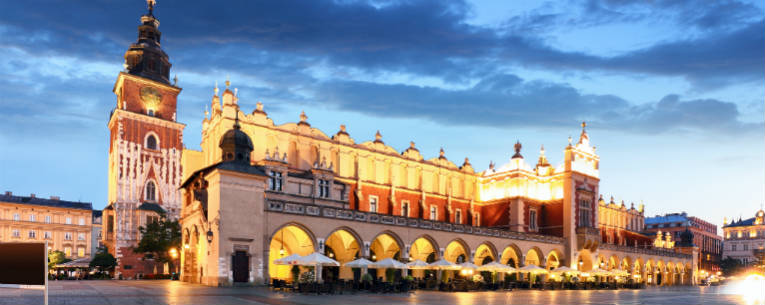It’s cheaper than Prague. Less crowded than Paris. It has more heart than Berlin. And it has more of its original parts than London.
Kraków, or Cracow, is an ascendant European city and an increasingly popular destination for history lovers, romantics, art fans, and beer and vodka aficionados. The capital of Poland until 1596, Kraków is a city on the upswing, where ancient architecture and modern attractions are coming together in such that the city is garnering a number of awards and accolades, such as the Top Off-the-Beaten-Path Destination for 2016.(1)
Before we walk through some of Kraków’s most popular attractions, let’s first look at why Poland’s “Second City” is in demand more now than ever before.
Why Kraków now?
Kraków has always been on the map. (It’s right across the border from the Czech Republic.) But for a good while, the city owed most of its foreign tourists to budget-minded British travelers who scored a cheap three-hour flight.
The city surely gained a bit more luster when it joined the European Union in 2004. If nothing more, this move shone a light on Kraków’s relative thriftiness. You can find beer for 1 Euro. You can find a private room in a hostel for 15 Euros.(2) And if you’re looking for a deal on a traditional double hotel room, you can find one for 55 Euros.(3)
But price alone is not the sole reason for the skyrocketing popularity of Kraków, which welcomed 10 million tourists in 2015 — 150,000 more than the previous year. (4) A growing cuisine and arts scene, including a big spike in gallery openings, builds an eclectic itinerary for travelers of diverse tastes.
Where to go in Kraków
Poland’s former capital city is one of the few European cities to make it through the ravages of war fairly unscathed, somehow surviving Mongol hordes, German occupation and Soviet invasion. For this reason, there is just so much to explore, from the old world and new world.
It all starts with Grand Square, also called the Grand Market or Main Square, which are translated from Rynek Główny. The 10-acre square is teeming with merchants, museums, churches and pierogi stands that are just too hard to pass up. In fact, it’s among the largest or quite possibly the largest such square in Europe. Part of Kraków’s Old Town, Grand Square features such magnificent structures as Cloth Hall, built in the 16th century during the Renaissance, as well as Town Hall Tower, a 14th century Gothic structure. These are impressive, massive buildings unlike anything modern architecture has to offer.(5) In fact, you really need to see the Grand Square in person to appreciate the enormity of it all.
Europe is overflowing with castles. And once you tour a few, you can certainly start to get desensitized to their charm and history. An intricately woven 700-year-old tapestry is just a dusty rug hung upside down. And one buttress perched at an impossible angle is no different than another. But Kraków’s Wawel Castle is a can’t-miss castle. The former home of Poland’s government, the landmark has bent but never broken through centuries of battles and occupation by Swedish and Prussian forces. Still being patched up here and there, the sprawling structure has been transformed into a museum, which includes tours of the Crown Treasury & Armoury, Royal Private Apartments and world-famous art including Leonardo da Vinci's “The Lady with an Ermine.”(6)
While Kraków’s city center escaped many sieges and shelling through the centuries of conflict, some of history’s most horrific atrocities took play in the 20th century just outside the city. The town of Oswiecim was home to Auschwitz, a network of Nazi concentration and death camps built by the Third Reich during World War II that claimed more than one million lives in just over four years. Admission to the grounds is free, but guests are asked to reserve entry cards in advance at visit.auschwitz.org. There is a fee for guides, which are required for group visits. Visitors are urged to be respectful, dressing appropriately and avoiding selfies, and it’s not recommended to bring children under 14 years of age.(7)
After a somber visit to Auschwitz, you owe yourself a trip to see Schindler’s Factory Museum, formerly called the Oskar Schindler Enameled Goods Factory. This is where businessman Oskar Schindler famously saved hundreds of workers, a story detailed in the Oscar-winning film, “Schindler’s List.” In addition to recounting this story, the museum also shares the larger narrative of the Nazi occupation of Kraków, which took place from 1939 to 1945.(8)
A tour of Kraków doesn’t simply need to be history lesson. Poland's Second City is also a modern city coming into its own. To soak it in, start with some art at the new-ish Museum of Contemporary Art, which includes such ambitious and over-the-top works as Tomasz’s Bajer’s full-scale copy of of a Guantánamo Bay prison cell. Then sneak in some vodka tasting; this is Poland, after all. Wodka Café Bar, with 100 bottles to choose from, is a great place to put your palate to work. Try the hazelnut vodka, a local specialty. Then make a night of it in Kazimierz, the historical Jewish quarter, which is filled with dive bars, beer gardens and other spots to quench your thirst and make stories with new friends.(9)
It’s prime time to visit Kraków. The crowds are big, but not overwhelming. The prices are just right. And the tourist traps have yet to be laid. It’s time to start defrosting some Mrs. T’s Pierogies — available in your grocer’s frozen food section — and plotting your itinerary. Right now.
Mike Ward is a copywriter, family columnist and sometimes comic who lives in Richmond, Va. with his wife, two young kids and two mutts. He likes long road trips and rooting for losing sports teams.
What Do I Need to Travel to Kraków?









Share this Page